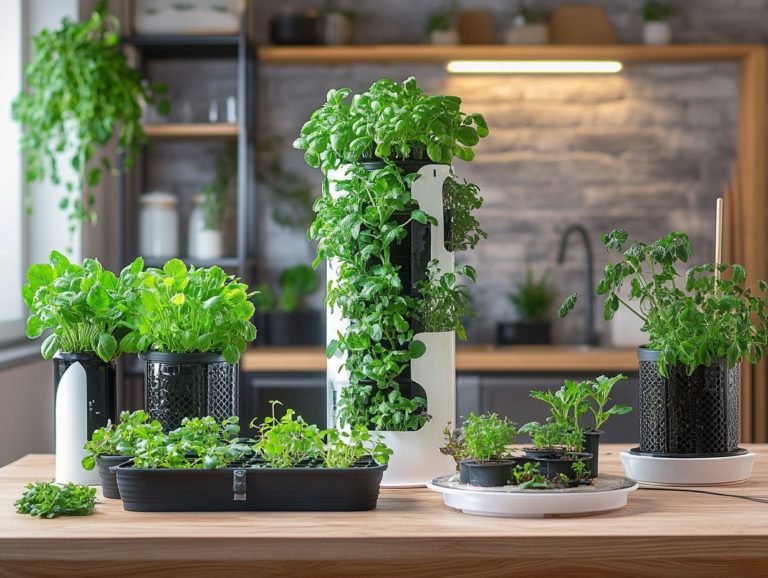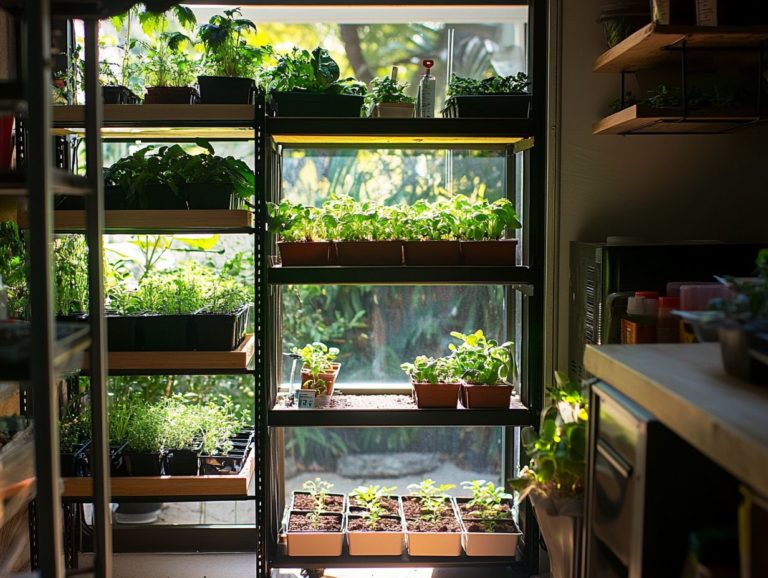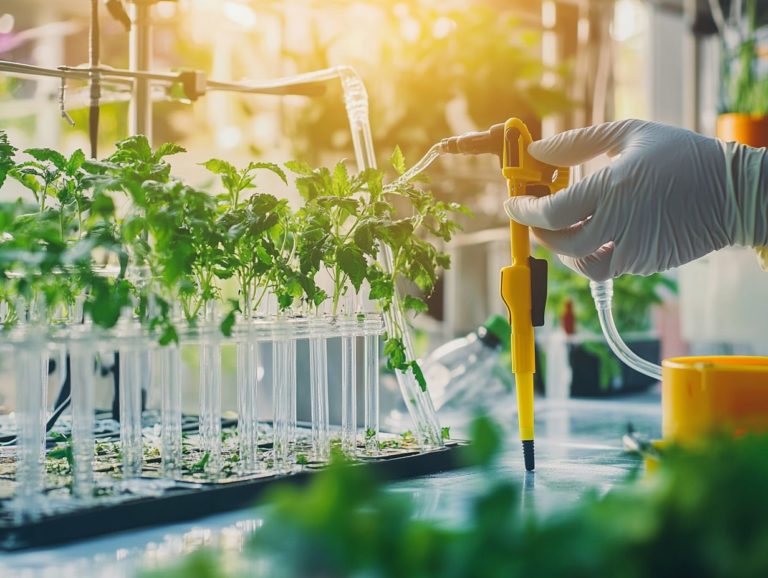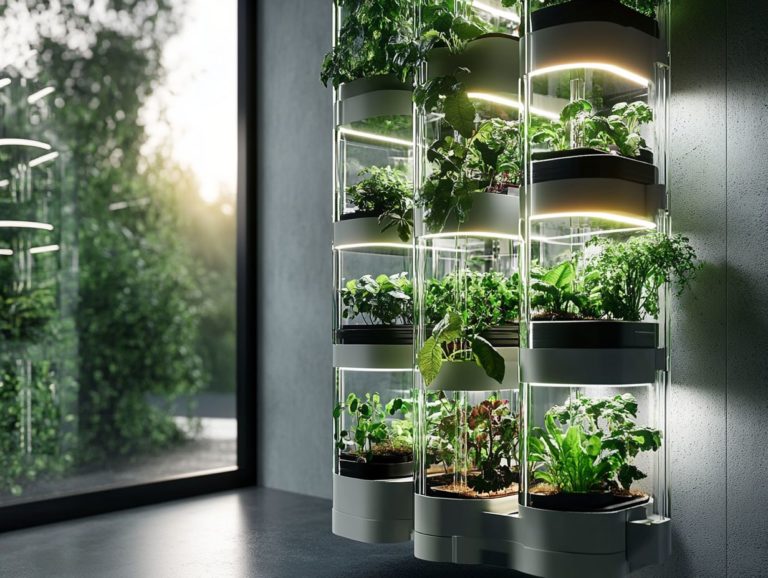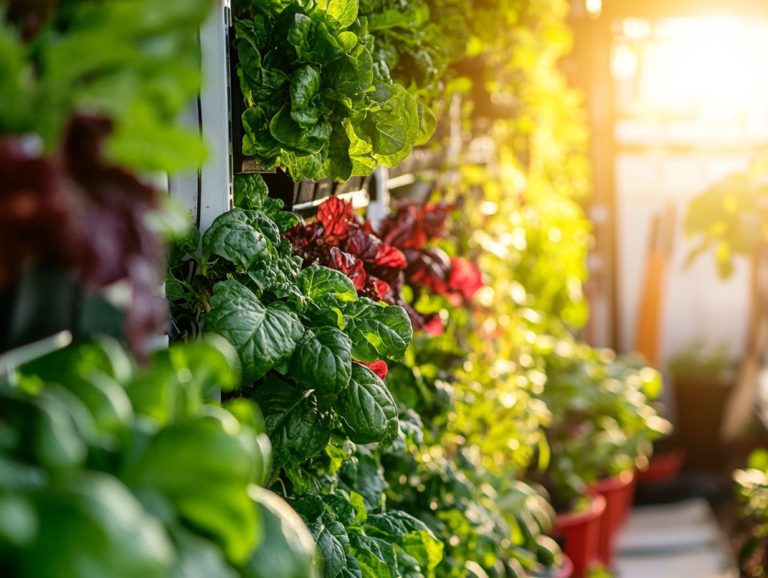How to Make Hydroponic Nutrient Solutions?
Hydroponic gardening has transformed the way you cultivate plants, presenting a soil-free alternative that flourishes on nutrient-rich solutions.
You might wonder, what exactly are these hydroponic nutrient solutions, and how do they foster healthy plant growth? This article delves into the components of these essential mixtures, covering everything from big nutrients to the often-overlooked small nutrients.
You ll also discover practical tips on mixing and measuring solutions, empowering you to customize them to meet the unique needs of various plants. By the end of your reading, you’ll possess the insights needed to optimize your hydroponic system for maximum yield and vitality.
Jump in now and discover the exciting secrets to thriving hydroponic gardening!
Contents
- Key Takeaways:
- Components of a Nutrient Solution
- Mixing and Measuring Nutrient Solutions
- Adjusting Nutrient Solutions for Different Plants
- Frequently Asked Questions
- What are hydroponic nutrient solutions and why are they important for growing plants?
- What ingredients do I need to make a hydroponic nutrient solution?
- How do I mix the ingredients to make a hydroponic nutrient solution?
- Can I make my own hydroponic nutrient solution at home?
- How often should I change the hydroponic nutrient solution?
- Are there any common mistakes to avoid when making hydroponic nutrient solutions?
Key Takeaways:

What are Hydroponic Nutrient Solutions?
Hydroponic nutrient solutions are specialized water-based concoctions that deliver essential nutrients for plant growth in hydroponic systems, while sidestepping traditional soil-based methods. This means you can customize nutrient levels to cater specifically to the needs of your crops, optimizing both their health and yield.
By using a carefully balanced blend of big nutrients and small nutrients, hydroponic systems ensure that nutrients reach the plant roots efficiently. This promotes vigorous growth and enhances food safety. Key players in this nutrient orchestra include calcium nitrate, potassium nitrate, and trace minerals like zinc and iron. All are crucial for maintaining the perfect nutrient balance in these innovative growing systems.
This tailored approach not only enhances crop performance but also minimizes resource waste, making it a sustainable choice for modern agriculture.
With the right hydroponic nutrient solutions in your toolkit, your plants will absorb nutrients more effectively. This results in quicker growth cycles and bountiful harvests. The ability to customize these nutrient mixes allows you to meet the specific needs of various plant species, boosting overall crop resilience.
This precision in nutrient management is vital for achieving optimal growth and ensuring consistent quality and flavor in your produce. Ultimately, this benefits consumers and contributes to food security, particularly through effective nutrient levels.
Advantages of Using Nutrient Solutions
Utilizing nutrient solutions in hydroponics presents a wealth of advantages, particularly in enhancing plant nutrition and ensuring food safety. Both are vital components of sustainable agricultural practices, including the use of homemade nutrients.
These solutions create an optimal environment for your plants to thrive. You can tailor nutrient profiles specifically to meet the unique needs of your crops. By embracing a hydroponic system, you can significantly reduce resource consumption, such as water and space, while achieving superior crop quality.
This method delivers nutrients straight to the roots, giving your plants a powerful boost! The controlled environment further minimizes the need for chemical inputs, promoting food safety and resulting in cleaner yields.
In essence, nutrient solutions are transforming the way food is grown, making agriculture not only more efficient but also more environmentally friendly.
Ready to grow? Start your hydroponic adventure today!
Components of a Nutrient Solution
A well-structured nutrient solution is essential for your hydroponic endeavors. It comprises a blend of crucial components tailored to meet the specific needs of your plants. Macronutrients like nitrogen, phosphorus, and potassium form the foundation of robust plant health. Additionally, secondary nutrients such as calcium, magnesium, and sulfur help plants work properly in various physiological processes.
Don’t overlook the importance of micronutrients either! Iron, manganese, zinc, copper, boron, and molybdenum are needed in trace amounts to foster optimal growth and development. By fine-tuning your nutrient levels and utilizing customized formulas, you can create the perfect environment for your plants. This ultimately leads to enhanced crop yields and superior quality.
Essential Nutrients for Plant Growth

The essential nutrients for plant growth fall primarily into the realm of macronutrients. Nitrogen, phosphorus, and potassium are critical for vibrant development. Nitrogen supports lush leaf and stem growth. Phosphorus strengthens robust roots and boosts flower formation. Potassium enhances overall plant vigor and resilience against diseases.
Ensuring adequate levels of these nutrients within your solutions promotes robust plant health. This can lead to higher yields and superior quality crops.
In hydroponic systems, leafy greens like lettuce thrive in a nitrogen-rich environment that encourages abundant foliage. In contrast, tomatoes and peppers flourish with enhanced phosphorus levels that boost their root structure and blooming. Meanwhile, potassium helps plants like cucumbers develop resilience to stress and disease.
This synergy among macronutrients caters to the specific needs of individual plants and optimizes the overall health of your system. Mastering the balance of these nutrients allows you to cultivate a thriving, sustainable crop that maximizes your efforts in hydroponic gardening. Don’t miss out on giving your plants the best chance to thrive!
Secondary and Micronutrients
Recognizing the vital role of secondary nutrients and micronutrients is essential for supporting plant health and optimizing growth in hydroponic systems. Secondary nutrients like calcium, magnesium, and sulfur are crucial for maintaining cell structure and enabling essential processes.
Micronutrients, including trace minerals such as zinc, copper, iron, and boron, are required in tiny quantities but are equally important for plant nutrition.
A balanced supply of these nutrients allows your plants to perform crucial functions like photosynthesis and nutrient uptake, contributing to improved yields and sustained growth within soil-less media, which means growing plants without traditional soil.
Calcium is particularly beneficial for root development and cell wall stability. It effectively prevents disorders like blossom end rot in your crops. Magnesium is vital for chlorophyll production, impacting photosynthesis efficiency. Sulfur plays a critical role in synthesizing amino acids and proteins, which are fundamental for growth and development.
Conversely, deficiencies in micronutrients can lead to stunted growth, chlorosis, and an overall decline in plant vigor. A lack of iron often shows as yellowing leaves, while insufficient zinc can stunt plant growth. Therefore, maintaining adequate levels of both secondary and micronutrients in your hydroponic nutrient solutions is crucial for fostering healthy plants.
Act now to unlock the full potential of your hydroponic garden!
Mixing and Measuring Nutrient Solutions
Mixing and measuring nutrient solutions with precision is essential for achieving the ideal nutrient balance in hydroponics. This balance fosters optimal plant growth and productivity.
Start by selecting the right components tailored to the specific needs of your crops. Then, meticulously measure each nutrient to craft a custom formula.
Mastering proper mixing techniques is vital. This ensures that all nutrients are evenly distributed throughout the solution, thereby avoiding any deficiencies or toxicities that could jeopardize plant health.
Regularly monitoring nutrient levels and pH levels is crucial for maintaining an effective nutrient solution throughout the entire growth cycle.
Calculating the Right Ratio
Calculating the right nutrient ratios is crucial for creating effective nutrient solutions tailored to your plants’ specific needs in hydroponics. Each plant species has unique requirements for big nutrients (like nitrogen, phosphorus, and potassium) and small nutrients (like iron and zinc), making precise calculations essential for optimal growth.
By analyzing the specific nutrient demands of your crops and adjusting the ratios accordingly, you can enhance nutrient uptake and maximize your yield. Utilizing established guidelines and tools will streamline this process.
To determine these nutrient requirements, kickstart your success with soil tests and leaf analysis. These tests provide valuable insights into nutrient levels and deficiencies.
For instance, leverage nutrient calculators or software that allows you to input crop types and growth stages, generating tailored nutrient ratios. Tools like EC meters and pH testers can help you monitor the effectiveness of your nutrient solutions in real time.
If you’re cultivating tomatoes, for example, calculate specific ratios of nitrogen, phosphorus, and potassium based on the plant’s growth cycle. Adjust for increased nutrient needs during flowering to promote better fruit development.
Such practical applications empower you to create a dynamically nutrient management strategy that adapts to your plants’ ongoing demands.
Tools and Techniques for Mixing
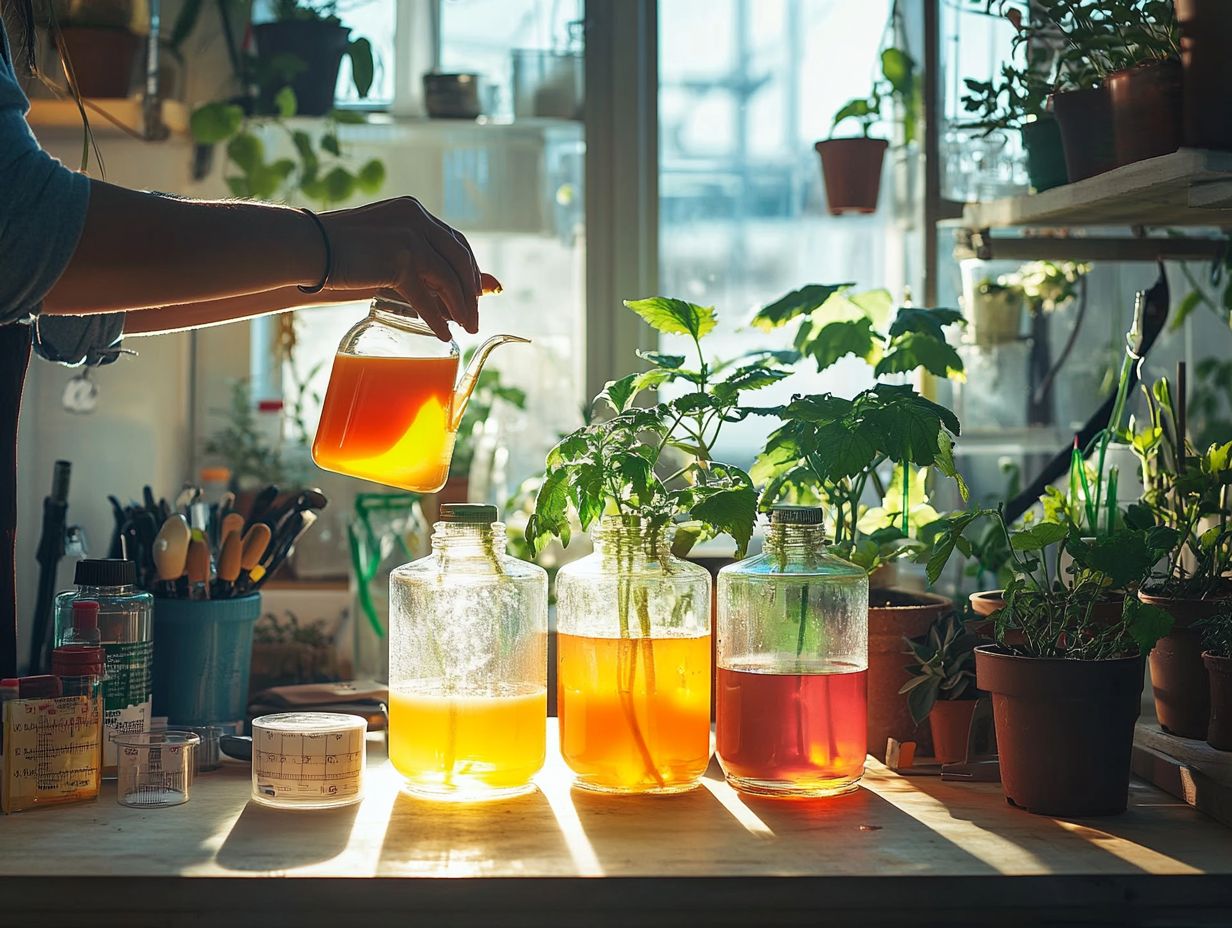
Employing the right tools and techniques for mixing nutrient solutions is essential for maintaining consistency and effectiveness in hydroponic systems. Even slight discrepancies in nutrient mixtures can significantly impact plant growth and yield.
For example, utilizing digital scales allows you to achieve precise measurements. pH meters are invaluable for monitoring acidity levels that are crucial for nutrient availability.
Consider using a high-quality paddle mixer for large batches to ensure the best results. Opting for slow mixing instead of vigorous stirring can help prevent foam formation, which might impede proper nutrient dissolution.
By adhering to these best practices, you support uniformity and enhance the efficacy of your nutrient solutions, ultimately fostering healthier, thriving plants.
Adjusting Nutrient Solutions for Different Plants
Adjusting nutrient solutions for various plants is crucial for optimizing their growth and meeting specific crop requirements in hydroponic systems. Each plant species has unique nutrient needs, and you must consider factors like growth stage, environmental conditions, and physiological characteristics.
By customizing nutrient solutions to cater to the distinct requirements of each plant, you can significantly boost growth rates, enhance yield quality, and promote overall health.
This tailored approach ensures that nutrient uptake is maximized, paving the way for successful hydroponic cultivation.
Understanding Plant Needs
Understanding the needs of your plants is essential for ensuring that nutrient solutions effectively promote growth and health in hydroponics.
Each plant species has unique nutrient requirements that vary according to its growth stage and environmental conditions. Therefore, it is vital for you to grasp its biological processes fully. This knowledge gives you the power to pinpoint critical growth stages where specific nutrients become essential, such as during flowering or fruiting phases.
Environmental factors like humidity, temperature, and light can significantly influence nutrient uptake. By evaluating elements such as leaf absorption rates and root development, you can tailor your nutrient solutions to meet the precise needs of your crops.
This understanding helps you create customized nutrient solutions that enhance plant health and productivity, ultimately leading to more successful and sustainable hydroponic practices.
Modifying Solutions for Optimal Growth
Modifying nutrient solutions for optimal growth is crucial for achieving exceptional results in your hydroponic systems. By continuously monitoring nutrient levels and adjusting the composition according to the various stages of plant growth, you can ensure your plants receive the perfect balance of essential nutrients needed in large and small amounts.
Technology such as sensors and automated monitoring systems helps you collect real-time data, enabling you to respond swiftly to any fluctuations in nutrient solution quality. Regularly assessing visual cues from your plants like leaf color and growth patterns provides further insights for necessary adjustments. For example, if you notice signs of nutrient deficiency or toxicity, a timely intervention can restore your plants’ health and vigor.
By employing these methods, you can fine-tune your approach, leading to robust growth and enhanced productivity, all while promoting a more sustainable and efficient farming practice.
Frequently Asked Questions
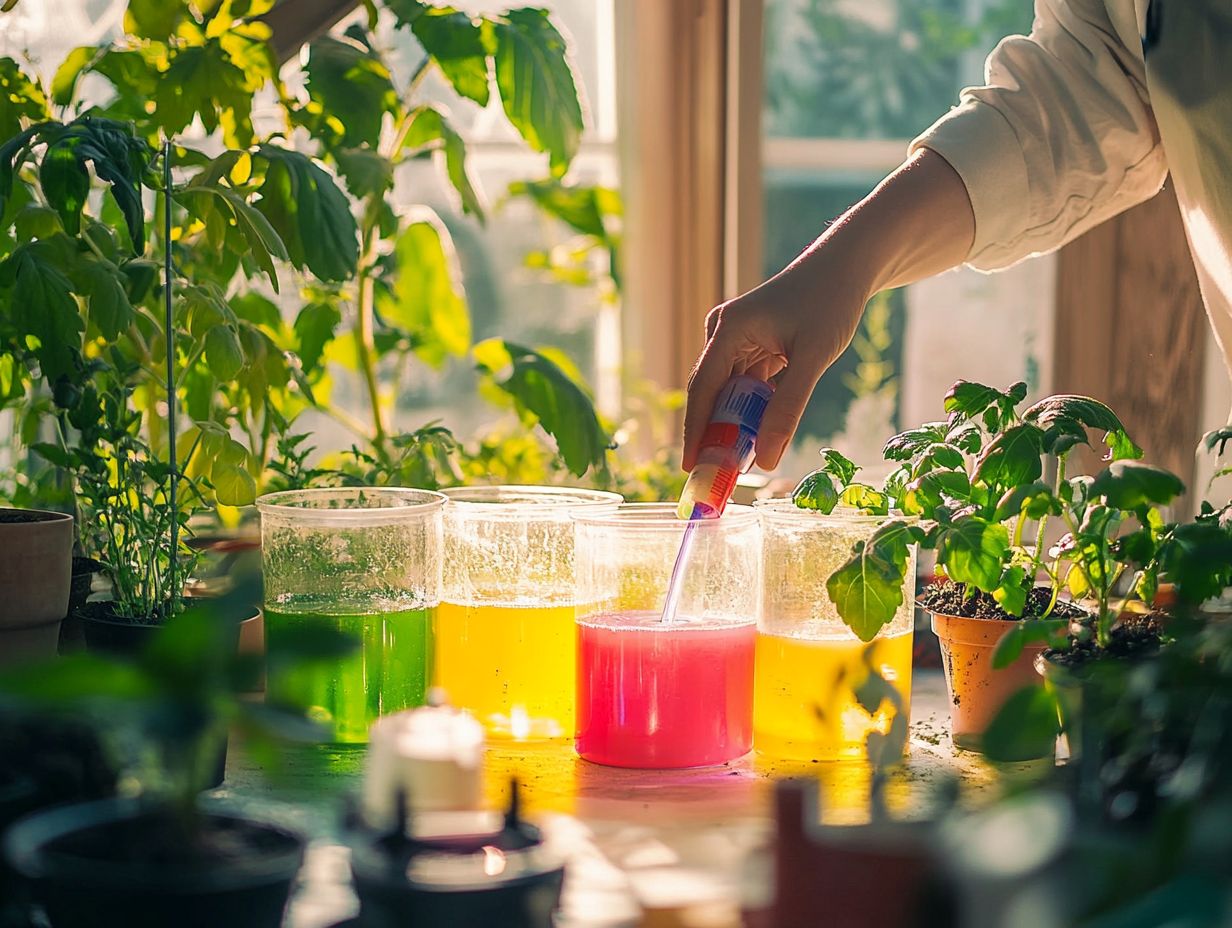
What are hydroponic nutrient solutions and why are they important for growing plants?
Hydroponic nutrient solutions are liquid fertilizers used in systems for growing plants without soil. They provide essential nutrients for plant growth. These solutions are important because hydroponic plants do not have access to natural soil nutrients, making the nutrient solution their main source of nourishment.
What ingredients do I need to make a hydroponic nutrient solution?
The ingredients for a basic hydroponic nutrient solution include water, calcium nitrate, potassium nitrate, and magnesium sulfate. Feel free to add other nutrients and supplements for even better results based on specific plant needs.
How do I mix the ingredients to make a hydroponic nutrient solution?
To make a hydroponic nutrient solution, mix the dry ingredients (calcium nitrate, potassium nitrate, and magnesium sulfate) in a large container of water. Use a fertilizer calculator or follow a recommended recipe to determine the correct ratio of ingredients for your specific plant needs.
Can I make my own hydroponic nutrient solution at home?
Yes! You can make your own hydroponic nutrient solution at home using readily available ingredients. This allows you to customize the nutrient solution for your specific plants and can be a cost-effective option compared to buying pre-made solutions.
How often should I change the hydroponic nutrient solution?
The frequency of changing the hydroponic nutrient solution depends on the type of system you are using and the rate at which your plants are consuming the nutrients. In general, it is recommended to change the solution every 1-2 weeks to ensure optimal nutrient levels for plant growth.
Are there any common mistakes to avoid when making hydroponic nutrient solutions?
Yes, some common mistakes to avoid include using tap water (which may contain harmful chemicals), not measuring and adjusting the pH level of the solution, and using incorrect ratios of ingredients. It is crucial to follow a recipe or use a fertilizer calculator to ensure the correct balance of nutrients for your plants.

